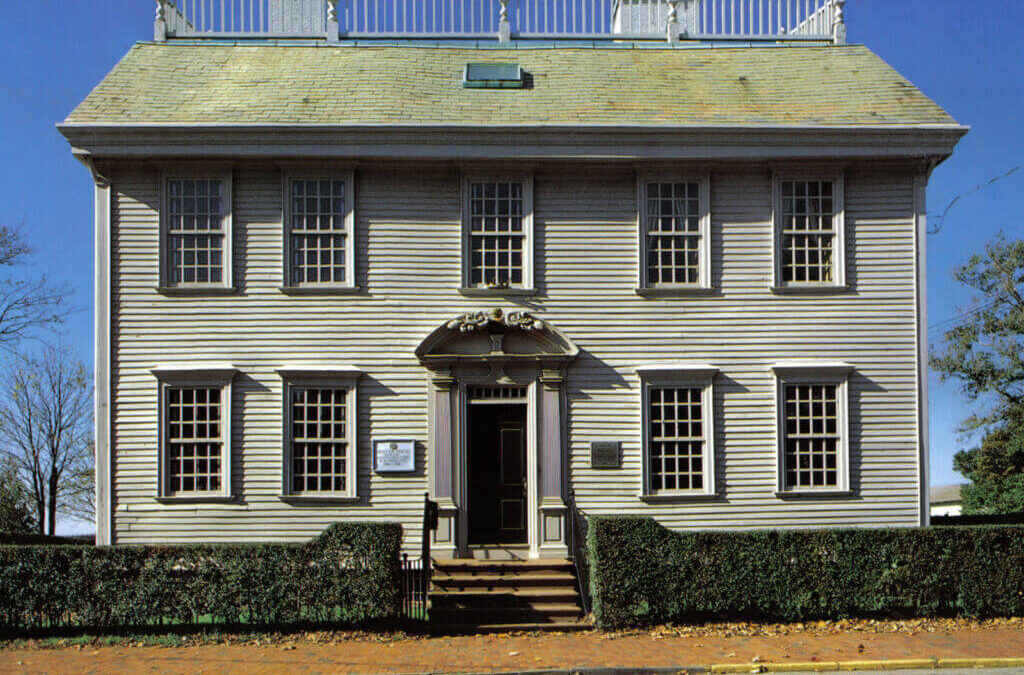Newport is fortunate to be a treasury of great architecture from a wide variety of periods. By a combination of happy accident and hard work, unlike many places where great works of architecture have been lost to successive periods of growth, Newport has maintained its architectural legacy. The history of Newport architecture falls roughly into 4 distinct periods: Colonial settlement, Early Victorian period, the Gilded Age and the Modern Era.
Colonial Settlement (1639-1810):
Early on, Newport was a wealthy Colonial city – the 5th largest in North America at the date of the Declaration of Independence. As a result, it had a large number of structures from that era including some of the earliest structures of their type. These notable buildings include the Quaker Meeting House (1699), The Old Colony House (1739), Trinity Church (1742), the Redwood Library (1747), the Touro Synagogue (1758), the Brick Market (1768), and many others still standing today. These buildings largely fall into four architectural styles: Colonial Settlement, Early Georgian, Mid-Georgian, and Late Georgian. One particularly outstanding example of the Georgian Style is Hunter House on Washington Street. This building was the first acquisition of the Preservation Society of Newport County in 1945 and is open for visitation by appointment, as it is very compact in size.
Unlike several of the other major Colonial cities (New York, Boston, and Philadelphia) after the Revolutionary War, Newport underwent a long decline in population and economic prospects. This had the effect of, somewhat accidentally, preserving many of the colonial structures and instilling a care and thriftiness within the Newport community. For 100 years, buildings were rarely torn down but more commonly disassembled and moved when they had outlived their purpose at a particular site. This native bend towards practical architectural preservation is perhaps one of the reasons that Newport and the American architectural preservation movement have become so closely aligned over the proceeding centuries.
Colonial architecture, while present throughout the city and Aquidneck Island (where Newport is located), is most densely present in two neighborhoods: the Point, and Historic Hill. These are the neighborhoods located to the West and South of Washington Square, which was the original common around which the settlement of Newport grew after its founding in 1639. The houses in these areas are compact and closely located by modern standards, but were gracious and elegant homes when they were built in the 17th and 18th centuries. The vast majority of these buildings have been lovingly restored and modernized, and the owners and residents of these homes love being right in the heart of the city and able to easily walk to restaurants, stores, and other community buildings, like libraries and theatres.
Washington Square was renamed from Queen Anne Square upon the death of the first President of the United States in 1799. It was the place where General Washington first gathered the Continental Army and French Expeditionary Force together for their long march into battle with the British Army, at last leading to the American forces’ final victory at the Battle of Yorktown. There are more than two dozen National Historic Landmarks (the highest honor an individual building can be given by the Secretary of the Interior) within half a mile of Washington Square, which is one of the densest concentrations of these important structures anywhere in the country.
Following historical periods (Early Victorian period, the Gilded Age and the Modern Era) will be posted in the upcoming weeks as a blog series.
Looking to remodel your home? Let’s connect.
Join the Architectural Forum to stay up-to-date with architectural news from Rhode Island and abroad.
